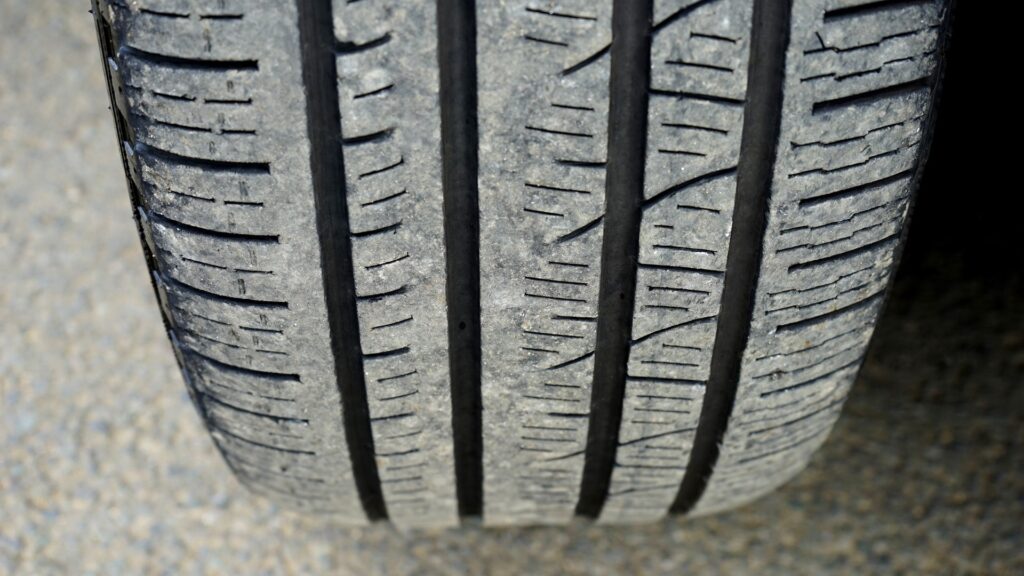Tires last between 60,000 and 75,000 miles or about 4 or 5 years. However, there are many variables to consider that affect the life expectancy of your tires. In this article, you will find information about which these factors are and how they affect your tires’ lifespan.

Some of the most important factors that should be considered to estimate your tires’ lifespan are:
Type of tire and compounds
As you may already know, there are different kinds of tires. The most common types are all-season, performance, summer, winter, and all-terrain tires. The components used to manufacture this kind of tires vary depending on their intended use, their quality, and the treadwear rating, which is an estimate of how long the tread will last.
Many materials are used to manufacture a tire. The most common are rubber (natural and synthetic), fabric, polyester, wire, carbon black, and other chemical compounds. The chemicals used and the quality of the materials depends on the tire’s brand, price range, and speed rating. High-performance tires, for example, are usually made of soft compounds that heat up quickly to improve their grip. These tires usually last less than conventional tires, which are made of harder compounds. All-terrain tires are designed to be used off-road; they wear faster when they are used on paved roads. Winter tires are harder than summer tires, and all-season tires harness is in between.
Driving Style
Your driving style affects the lifespan of your vehicle’s tires. Fast starts and stops wear your tires faster because they are subject to heavier loads and sudden temperature changes. It’s well known the sportier your driving style is, the more wear your tires will suffer, not to mention things that you shouldn’t do on the streets, like burnouts, which actually burn rubber out of your tires. Driving carefully, avoiding potholes, and not pushing your vehicle to the limits will help to extend your tires’ lifetime.
Fitting your vehicle with the right tires
There are different models of tires of the same size. Some SUVs and cars come with wheels of the same diameter and tires that seem to be the same. However, if you take a deeper look, you will find that the specs of an SUV’s tire are not the same as the specs of a car’s tire. They may even look the same but they have different speed ratings and load indexes. Tires made for an SUV handle more weight than tires made for a car. When you are replacing your tires, check that you are fitting your vehicle with new tires that suit it. Sometimes buying new tires for your vehicle can be a bit confusing. You just have to check your vehicle’s user manual to see which are the right tires for your vehicle.
Loading too much weight
Overloading your vehicle is not only dangerous but also harmful for your tires. If you need to load your vehicle heavy, you should first check your vehicle’s tire and loading information label. There you will find important information about your tires, your vehicle’s load limits, the recommended tire pressure, and more. This label/sticker can often be found on the inside of the driver’s door frame, or inside of the fuel filler cover.
Road Conditions
Poor road conditions such as gravel, dirt, or bumpy roads cause more wear to your tires than smoothly paved roads when you are not using off-road tires. When your car is fitted with off-road tires, it is the other way around; they are made to withstand hard roads, but they are not made to endure the heat that is produced while driving on the highway.
Tire Maintenance
Several points are key to keeping your tires in good shape and maximizing their lifespan.
– Pressure: overinflation and underinflation of the tires make them produce more heat. Besides, when tires are too underinflated they are prone to suffer structural damage. When tires have very low pressure, the internal metal mesh gets deformed. If the tires run for a long time in that way, the deformation can be permanent. Another problem is that heat degrades the rubber, creating cracks that can’t be fixed.
Another reason why it’s important to keep the tires’ pressure within the manufacturer’s specs is to prevent uneven wear.
– Tire Rotation: front and rear tires endure different loads. Rotating the tires frequently (between 5,000 to 8,000 miles) also prevents uneven wear. If you don’t rotate the tires of your vehicle, you should replace the tires that support more weight sooner.
– Balance and Alignment: properly balanced wheels help to avoid uneven tire wear patterns. Misaligned wheels lower the tires’ lifespan. It’s advisable to balance and align the wheels every time they are rotated.
Weather and Environment
Tires used in regions with low temperatures tend to be used with low pressure at the risk of being underinflated. On the other hand, in areas with high temperatures, the pavement is extremely hot, which creates more friction between the tires and the road. In both conditions, the tires may last less than expected.
Exposure to sunlight, extreme weather conditions, oil, grease, and other chemicals will also shorten the lifespan of your tires.
Tire Manufacturing Date
Whether they have been used or not, tires deteriorate over time. Tires start deteriorating as soon as they leave the production line. All tires have their manufacturing date marked on their sidewalls with four digits. The first pair of digits indicate the week and the second the year when the tire was made. When you are buying a new set of tires you should check for that information. If the tire doesn’t wear out before, you will have to replace it between 4 and 5 years after the date indicated on the tire’s sidewall. If the vendor had the tires stored on a shelf for, let’s say, two years, you will practically be buying a set of used wheels, even if they look as good as new. Many manufacturers offer their dealers to return tires older than two years. Old tires are prone to crack and fail suddenly. It can be really dangerous driving a vehicle with tires older than 6 years.
Conclusion
As described above, it’s hard to predict accurately how long your tires are going to last. The best thing you can do is to check them frequently; for example, at every oil change. Remember to rotate them between 5,000 and 8,000 miles, or check your vehicle’s user manual to check how often your vehicle manufacturer advises doing it. Check for cracks and signs of premature wear. Check the treadwear marks and the tread depth to have an idea of how worn out your tires are but remember that it’s not a conclusive test. Check your tires for deformations, wall damage, and uneven wear. Finally, a last piece of advice: before buying new tires first check your vehicle’s tires and loading information, and when you are choosing your next set of tires, you can find great online information about how tires perform in all weathers. Tires are the only components of your vehicle that keep it in contact with the road, so try to choose the best tires you can buy.






